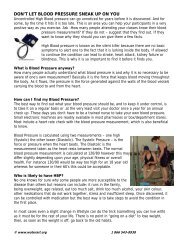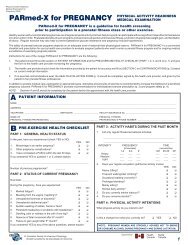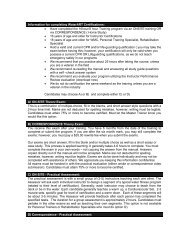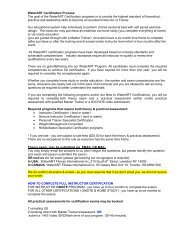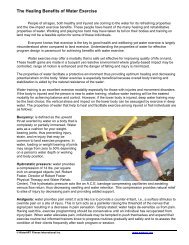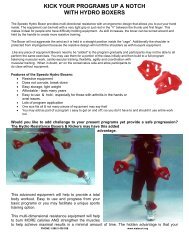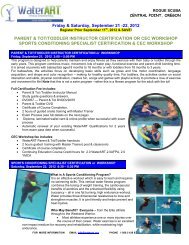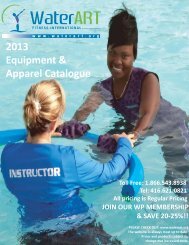WaterART Fitness International Guidelines for Land Fitness ...
WaterART Fitness International Guidelines for Land Fitness ...
WaterART Fitness International Guidelines for Land Fitness ...
You also want an ePaper? Increase the reach of your titles
YUMPU automatically turns print PDFs into web optimized ePapers that Google loves.
10. To send the participant to another program (i.e. Speciality training) should the participant not have the skill level to<br />
work safely within the program?<br />
11. To modify the exercise at patrons request<br />
12. To progress the exercise at the patrons request<br />
Instructor Code of Conduct<br />
1. Wear professional clothing and footwear<br />
2. Teach monitor and regulate intensity.<br />
3. Provide an appropriate warm up and cool down <strong>for</strong> all classes<br />
4. Do not jump, bounce or per<strong>for</strong>m too many repetitions of an exercise to cause stress or repetitive stress injuries<br />
<strong>WaterART</strong> ‘s <strong>Guidelines</strong> <strong>for</strong> Exercise Technique<br />
All patrons/clients should be able to see, hear & understand the exercise instructions in terms of purpose, safety and<br />
technique. <strong>WaterART</strong> realizes the challenge of facilitating multi-skilled and fitness levelled programs. Facilities, conditions<br />
and variety of patrons may be anything but perfect.<br />
1. Instructors may should not teach beyond their scope of practice nor fitness level<br />
2. Should drink water and encourage participants to do the same throughout a program<br />
3. Should never <strong>for</strong>ce anyone to per<strong>for</strong>m an exercise<br />
4. Should never manually adjust a person<br />
5. Should terminate the program if any conditions become hazardous to the instructor’s or participants’ well being.<br />
6. Be aware of voice injury. Utilize visual cueing and a microphone when possible.<br />
7. Execute movements in good posture in <strong>for</strong>m as an instructor –be a good model.<br />
8. Cue a neutral spinal alignment with each class –show how to maintain a good posture .<br />
9. Work within your own body’s limits – teach <strong>for</strong> long term – and injury prevention.<br />
10. When cueing show movements visually and explain verbally<br />
11. Demonstrate the “start position” of the exercise when showing a movement pattern.<br />
12. Demonstrate the “end position” of the exercise when showing a movement pattern.<br />
13. Do not keep the arms/hands above the head/heart <strong>for</strong> more than a minute (due to pressor response and an increase<br />
in blood pressure )<br />
14. Do not twist or torque the knees.<br />
15. Cue movement to keep the hips, knees, and toes to remain in a parallel alignment with walking and squats<br />
16. For muscular strengthening per<strong>for</strong>m at least 1-2 sets of 8-10 repetitions with equipment if possible or till muscle<br />
fatigue.<br />
17. For muscular endurance per<strong>for</strong>m at least 1-2 sets of 8-10 repetitions without equipment <strong>for</strong> optimal benefits.<br />
18. For Cardiovascular endurance moderate to low intensity <strong>for</strong> 3-10 minutes, 3-5 times a week will yield positive benefits<br />
19. Cardiovascular training should utilize primarily rhythmical lower body movements with safe change of direction.<br />
20. Utilize active flexibility in the beginning of a program and more static stretching at the end of a program<br />
21. All components of fitness are valuable in a program. Incorporate a mixture of muscle strength, flexibility, agility,<br />
coordination, balance, posture and cardiovascular <strong>for</strong>mats as suitable <strong>for</strong> the program <strong>for</strong> optimal per<strong>for</strong>mance<br />
training.<br />
22. State the purpose of the exercise when training. All components are important yet unique to train.<br />
23. Clients should not exercise if the resting heart rate is above 100 bpm<br />
24. All instructors should provide a suitable cool down period to gradually bring the heart rate down.<br />
<strong>Guidelines</strong> <strong>for</strong> Exercise Safety<br />
• There should be no radiation of pain into the arm or fingers, especially with neck movements.<br />
• Typically, you will have to strengthen the external rotators, rhomboids, lower fibers of the trapezius, posterior deltoids,<br />
triceps, biceps, and latissimus dorsi.<br />
Stretch the pectorals, anterior deltoid and subscapularis.<br />
Protect your Patrons shoulders against Impingement<br />
When overhead movement becomes uncontrolled and/or overworked, the humeral head begins to hit up against the acromion<br />
process. Impingement syndrome usually occurs between 70 and 120 degrees of abduction of the arm – this is also referred<br />
to as the "painful arc" when the humerus is internally rotated in the shoulder joint. This is a common occurrence if the arm is<br />
taken above 90 degrees with the hands facing down (such as when holding weights). Cue safe ROM to prevent rounding of<br />
the shoulders and impingement of the shoulder joint. Impingement usually progresses to rotator cuff tear. Weak areas to be<br />
aware of are scapular musculature, muscles of the rotator cuff and chest, and pronators/supinators of the <strong>for</strong>earm and hand.<br />
© <strong>WaterART</strong> <strong>Fitness</strong> <strong>International</strong> Inc. www.waterart.org



